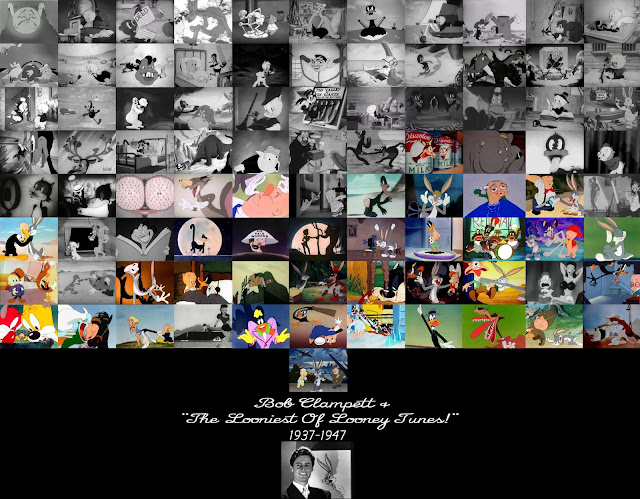"This is where animation begins...with a good story. Adventure...romance...humor...suspense..."
But when you get down to it, are cartoons about stories, or are they about characters and how the ideas are presented?
Recently, I got a message from someone asking me for advice, since he's interested in cartoons. His question was "I'm trying to be a writer. The thing is, I'm trying to write a 'literal' version of a cartoon, something like literary written. And I was wondering if you could give me some pointers, seeing as I see you draw a lot of the stuff from old cartoons, which by the way is so cool."
Warren Foster story sketch for a Yogi Bear cartoon, courtesy Stephen Worth's Animation Resources
I'm a very long ways from an animator, much less a pro animator, but I have been doing a lot of research on cartoons, and I don't mean trivia like "What was Walt Disney's favorite drink?"...
...or "Goofy's original name was Dippy Dawg"...
I mean understanding what cartoons have already done...what cartoons can do well...
and what cartoons haven't done yet.
While I believe story and writing are the least important part of cartoons, I have also been doing a lot of reading to get a clearer understanding of the difference between informal language and visual language--and to me, that is what sets apart writing and drawing.
My question is "Why would you want to write a 'literal' cartoon?"
When I get down to it, cartooning has to be an exaggeration of something real to make its point.
And there have been plenty of 'literal' cartoons--movies like "The Prince of Egypt", which take the mediums potential for caricature and exaggeration and reduce it to a set of polished symbols.
The noble hero and nice guy...
the cold-blooded monarch...
The shallow love interest...
The comic relief lackeys to the villain...
These may work as basic storytelling devices, but there's nothing real about them--they don't have the subtleties of live action despite being drawn with lots of anatomy, and they don't have the benefits of cartooning either, despite using basic elements of cartooning such as simplified shapes, details, and flat colors. They come off as sentimental abstractions, not people based on anyone you would meet or understand in real life.
And you can't beat real life for ideas--take for instance, E.C. Segar's "Popeye the Sailor"!
Did such a wonderful character spawn whole cloth out of the head of the cartoonist?
No--he was inspired by a man who actually existed, a grisly, rough n tumble alcoholic vagrant and friend of Segar named Frank "Rocky" Fiegel!
That an impossible cartoon like Popeye could spawn from a real person is just one example of how cartooning can take something real, use the clarity of drawing and highlight that persons personality, and then crystallize it into a three dimensional personality, something that has a life of its own that works as the authors opinion on life, rather than a symbol of a character or a mere copycat of reality.
Another thing I want to address is that even in writing, the story--the actual continuity and events of the work--in itself is not always the defining element of the work. In fact, in a book collection compiling the stories "Frankenstein", Dracula", and "Dr. Jekyll and Mr. Hyde"...
...the great Stephen King supplied an introduction, and surprisingly highlighted them as examples of books with average to mediocre prose or skimpy stories--such as how Jekyll and Hyde is a bare bone police case story until you find out the twist at the end--but he also points out that the characters in them were so three dimensional...
...and so unique...
...that they gained a life of their own outside of their original stories!
King also highlights how the Hyde story is not just a story about a man becoming a monster by a potion, but a story about a man who finds an excuse to allow himself to be resolved of responsibility and give in to temptation by allowing his evil side to run rampant without fear of his "good" side being punished.
I should also mention the stories of greats like Charles Dickens, who took real life experiences of his (such as growing up in working in the harsh conditions of a Blacking Warehouse) and made his stories as extremes of them to make a point (i.e. Oliver Twist), not unlike how a cartoon exaggerates something real to highlight the truth.
Cartoons should be an opinion on reality presented in visual hyperbole, not a reality unto themselves.
More recommended reading on cartoon "writing" at the links below!
http://johnkcurriculum.blogspot.com/2008/01/writing-for-cartoons.html (John Kricfalusi on Writing for Cartoons)
Stephen Worth's Animation Resources has done several articles about the subject of Writing for Cartoons, too!
Veteran Disney Animator Floyd Norman pitched in on the "Story" topic in his blog post "Requiem for a Gag Man"! http://floydnormancom.squarespace.com/blog/2015/5/5/requiem-for-a-gagman
P.S. Walt Disney's favorite drink was a Scotch Mist.
















































































































